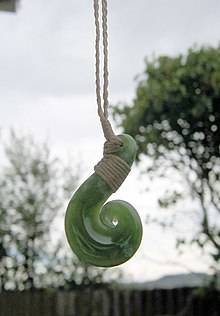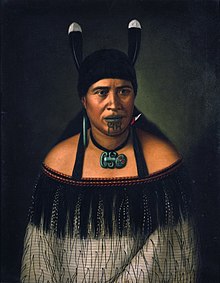Pounamu

Pounamu is a collective Māori term for several types of hard, permanent nephrite - jade and bowenite - found in New Zealand . In New Zealand English, pounamu is also used as a synonym for " greenstone ".
The most important subspecies are kawakawa , kahurangi , īnanga and tangiwai . The first three are made of nephrite jade, tangiwai is a form of bowenite. In linguistic usage today , pounamu almost exclusively denotes nephrite jade.
Pounamu is found in the rivers in the form of nondescript stones that are difficult to identify without cutting them open.
Meaning for the Māori
Pounamu plays an important role in the Māori culture. It is considered a taonga (treasure). It was used to make tools, jewelry and weapons. Adze , mere (short clubs) and Hei-tiki (neck pendants) were especially made. These, it was believed, had their own mana , they were passed on as valuable heirlooms and often used as gifts on important agreements to seal them.
Pounamu occurs only on the South Island of New Zealand, which the Māori refer to as Te Wai Pounamu ("The Pounamu Water") or Te Wahi Pounamu ("Place of Pounamu"). In 1997, the Crown returned ownership of all pounamu found on the surface to the Iwi Ngāi Tahu as part of the compensation under the Waitangi Treaty .
Pounamu jewelry is popular among New Zealanders and is often used as gifts for visitors. However, the jewelry that is often sold in souvenir shops is often made from cheaper Asian jade.
Web links
- Pounamu , Te Rūnanga o Ngāi Tahu
- Basil Keane : Pounamu - jade or greenstone . In: Te Ara - the Encyclopedia of New Zealand . Ministry for Culture & Heritage , October 5, 2015, accessed January 21, 2016 .
- First over the Alps: The epic of Raureka and the Greenstone by James Cowan (eText)
Individual evidence
- ^ Pounamu - several names. In: Te Ara - The Encyclopedia of New Zealand. Accessed February 2, 2020 .
- ↑ Implements and adornment. In: Te Ara - The Encyclopedia of New Zealand. Accessed February 2, 2020 .
- ↑ Environmental Kaitiakitanga. Te Rūnanga o Ngāi Tahu, accessed February 2, 2020 .
- ^ Ngāi Tahu and pounamu. In: Te Ara - The Encyclopedia of New Zealand. Accessed February 2, 2020 .
